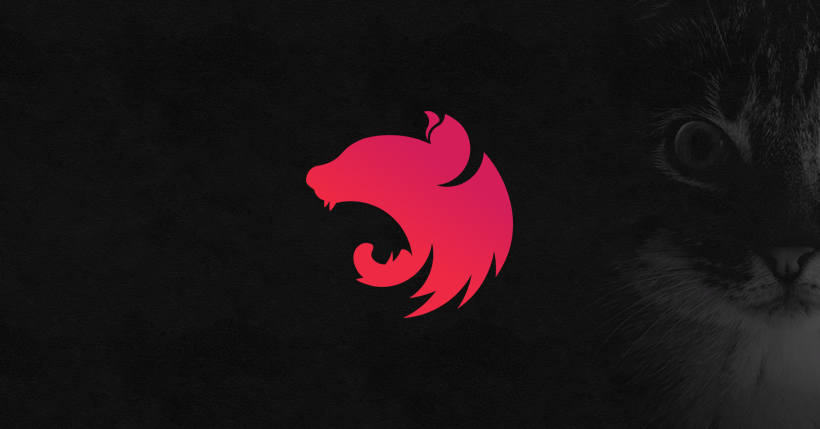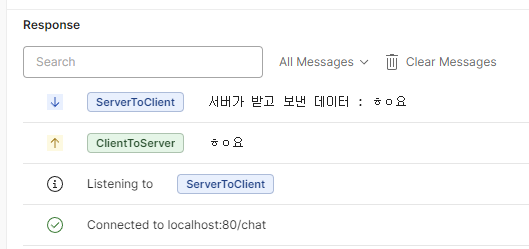
토이 프로젝트로 커뮤니티 웹을 만들고 있는데 유저들끼리 채팅 기능을 추가하기 위해
Socket.io를 사용하려는데NestJS에서는Express와 사용법이 조금 달라서 정리합니다.
WebSocket ?
HTTP의 단방향 통신
HTTP는 클라이언트가 서버에 요청을 보내고, 서버가 응답을 반환하는 단방향 통신을 기반으로 합니다.
채팅과 같은 실시간 통신에서는 양방향 통신이 필요하고 이러한 양방향 통신을 구현하기 위해서는
HTTP와 OSI 모델의 같은 계층(7계층)에 위치한 계 WebSocket과 같은
프로토콜이 필요합니다.
Node에서 Web Socket
Node에서는 웹 소켓을 구현하기 위한 두 라이브러리 ws와 socket.io가 존재하지만 ws보다는
socket.io가 구현하기 편하고 더 다양한 기능(room과 namespace 등)을 지원하므로
저는 socket.io를 사용하려 합니다.
NestJS에서 socket.io
Gateways
NestJS는 내장 기능으로 socket.io를 Gateways를 이용해서 지원합니다.
 https://docs.nestjs.com/websockets/gateways
https://docs.nestjs.com/websockets/gateways
Gateways도 providers로 취급되므로 사용하는 module에 providers로 추가하여야 사용할 수 있습니다.
패키지 설치
npm i --save @nestjs/websockets @nestjs/platform-socket.io
게이트웨이와 모듈 설치
nest g gateway events
nest g module events
events 게이트웨이와 모듈의 설치가 끝나면 EventsModule에 EventsGateway를 provider로 등록해 줘야 합니다.
만약 app.module에 EventsGateway가 프로바이더로 자동 등록되었다면 지우고 EventsModule에 등록하여 사용하는 게 바람직합니다.
//events.module.ts
import { Module } from '@nestjs/common';
import { EventsGateway } from './events.gateway';
@Module({
providers: [EventsGateway],
})
export class EventsModule {}Gateway 코드
import {
MessageBody,
SubscribeMessage,
WebSocketGateway,
WebSocketServer,
OnGatewayInit,
OnGatewayConnection,
OnGatewayDisconnect,
ConnectedSocket,
} from '@nestjs/websockets';
import { Socket, Server } from 'socket.io';
import { Logger } from '@nestjs/common';
@WebSocketGateway(80, { namespace: 'chat' })
export class EventsGateway
implements OnGatewayInit, OnGatewayConnection, OnGatewayDisconnect
{
private logger = new Logger('chat');
constructor() {
this.logger.log('constructor');
}
@WebSocketServer()
server: Server;
@SubscribeMessage('ClientToServer')
handleMessage(@MessageBody() data: string) {
this.logger.log(`received message : ${data}`);
this.server.emit('ServerToClient', `서버가 받고 보낸 데이터 ${data}`);
return `서버가 받은 데이터 ${data}`;
}
afterInit(server: Server) {
this.logger.log('init');
}
handleConnection(@ConnectedSocket() socket) {
this.logger.log(`connected: ${socket.id} ${socket.nsp.name}`);
}
handleDisconnect(@ConnectedSocket() socket: Socket) {
this.logger.log(`disconnected: ${socket.id} ${socket.nsp.name}`);
}
}@WebSocketGateWay
@WebSocketGateWay의 인자로 사용할 포트와 namespace을 설정할 수 있습니다.
두 번째 인자로는 namespace말고 다른 옵션들도 사용할 수 있습니다.
@WebSocketGateway(80, { namespace: 'chat' })위 코드는 80번 포트를 사용하고 namespace를 chat으로 설정한 코드입니다.
Lifecycle hooks
EventsGateway 클래스를 생성할 때 3가지 인터페이스를 상속 받았습니다.
-
OnGatewayInit는afterInit메소드를 구현해야 하고 -
OnGatewayConnection는handleConnection메소드를 구현해야 하고 -
OnGatewayDisconnect는handleDisconnect메소드를 구현해야 합니다.
위 세 가지 메소드 구현은 필수적이고 구현하지 않으면 EventsGateway 클래스 생성 시 오류가 발생합니다.
afterInit
afterInit 메소드는 웹소켓 서버가 초기화된 후 호출되는 메소드입니다.
이 메소드에서는 주로 웹소켓 서버와 관련된 초기 작업을 수행하거나 서버가 준비된 것을 로그로 남기는 작업 등을 할 수 있습니다.
위 코드에서는 클라이언트와 연결되기 전에 EventsGateway 클래스의 생성자 함수가 실행될 때 로그를 남기고
afterInit 메소드가 실행될 때 로그를 남기도록 작성했습니다.

서버 실행 시 위와 같이 로그가 정상적으로 남겨진 것을 확인할 수 있습니다.
handleConnection
handleConnection 메소드는 클라이언트와 연결되었을 때 호출되는 메소드입니다.
handleConnection(@ConnectedSocket() socket) {
this.logger.log(`connected: ${socket.id} ${socket.nsp.name}`);
}클라이언트와 연결되면 클라이언트를 식별할 값과 현재 방을 로그로 남기도록 되어 있습니다.
postman에 socket.io 워크스페이스를 생성하고 요청 주소에 설정한 포트와 namespace를 넣고 연결을 누르면

handleConnection 메소드가 정상적으로 실행된 것을 로그로 확인할 수 있습니다.

handleDisconnect
handleDisconnect 메소드는 클라이언트와 연결이 끊겼을 때 실행되는 메소드입니다.
handleDisconnect(@ConnectedSocket() socket: Socket) {
this.logger.log(`disconnected: ${socket.id} ${socket.nsp.name}`);
}postman에서 연결을 끊으면

handleDisconnect 메소드가 정상적으로 실행된 것을 로그로 확인할 수 있습니다.
@SubscribeMessage @MessageBody
@SubscribeMessage 데코의 인자로 수신할 Event의 이름을 설정할 수 있고
@MessageBody 데코로 클라이언트에서 온 데이터를 받을 수 있습니다.
@SubscribeMessage('ClientToServer')
handleMessage(@MessageBody() data: string) {
this.logger.log(`received message : ${data}`);
this.server.emit('ServerToClient', `서버가 받고 보낸 데이터 : ${data}`);
return `서버가 받은 데이터 ${data}`;
}클라이언트에서 온 데이터를 로그로 남기고 server.emit 함수로 클라이언트로 데이터를 보낼 수 있습니다.
postman에서 데이터를 보낼 때 Event 값을 ClientToServer로 설정하고
 수신할 이벤트를
수신할 이벤트를 ServerToClient로 설정하고

메세지를 보내면 클라이언트의 메세지가 서버 로그에 남고

클라이언트는 server.emit로 인해 서버로부터 메세지를 받습니다.
